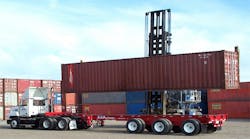The Federal Highway Administration’s (FHWA) draft designation of the Primary Freight Network (PFN) needs a sharper focus on the intermodal movement of freight, said the Intermodal Association of North America (IANA) in its recommendations to FHWA. Congress had directed FHWA to designate a 27,000 centerline mile highway PFN using eight factors to guide decision making.
“To increase the PFN’s effectiveness, a final designation must include Freight Intermodal Connectors, which have already been recognized as part of the National Highway System,” said Joni Casey, IANA president and CEO.
The focus of IANA’s recommendations are:
- Add National Highway System (NHS) Freight Intermodal Connectors to the PFN. Despite the critical link NHS freight intermodal connectors play in providing the actual ingress and egress between intermodal facilities and the NHS, they were not included in the draft PFN. IANA recommends that FHWA amend the PFN map to include all NHS freight intermodal connectors, as they facilitate maximized use of each transportation mode yet account for less than one percent of total NHS mileage. Further, IANA encourages FHWA to consult with the private sector and industry groups likely to have data beneficial to the agency’s work, such as that on intermodal connections.
- Designate Funding and Incentivize Private Investment: Citing an FHWA report to Congress, IANA notes that despite their integral role in intermodal freight movement, NHS freight intermodal connectors are underfunded when compared to the rest of the NHS and the cost of backlog improvements is over $2 billion. IANA encourages Congress to designate funding and incentivize private investment so the value of tools, such as the PFN, can be realized.
- Account for Multimodal Freight Movement: While appropriateness of the formal inclusion of privately-owned infrastructure remains unknown until FHWA and Congress have further defined the PFN’s purpose, IANA suggests infrastructure such as seaports and inland intermodal terminals be taken into account to provide information necessary for maximized investments – both public and private.
- Redefine the PFN through a Corridor Approach: IANA supports FHWA’s stated preference for a corridor approach as opposed to Congress’ call for a centerline mile designation capped at 27,000 miles. A corridor approach provides the required redundancies and alternate routes to allow optimized movement of goods, particularly in instances of recurring congestion and unanticipated disruptions within the supply chain.
The draft designation of the PFN was published in the Federal Register on November 19, 2013. FHWA requested comments on specific route modifications to the highway PFN, the methodology for achieving a 27,000 centerline mile designation, how the national freight network may fit into a multimodal national freight system, how the national freight network and components could be used in the future, and suggestions for an urban-area route designation.



